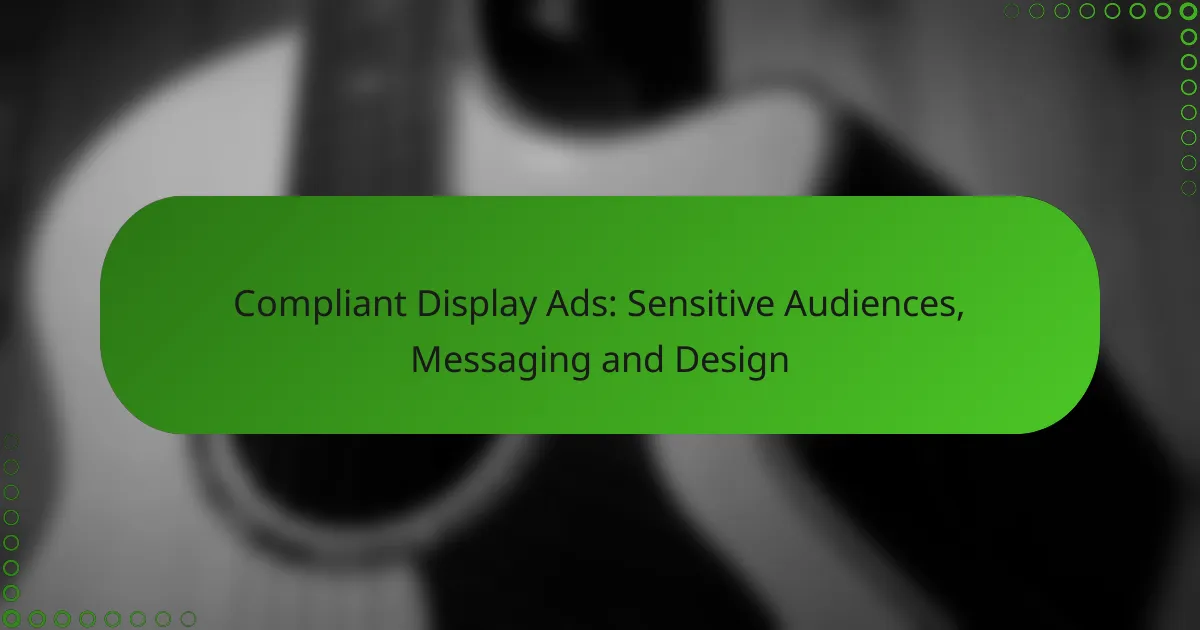Accessibility in display advertising is crucial for ensuring that all users, including those with disabilities, can effectively engage with advertisements. By adhering to specific guidelines and best practices, advertisers can create inclusive content that enhances usability and fosters a better user experience for diverse audiences. Implementing these strategies not only meets legal requirements but also promotes equal access to information and services for everyone.

What are the best practices for accessibility in display advertising?
Best practices for accessibility in display advertising ensure that all users, including those with disabilities, can engage with ads effectively. This involves implementing specific techniques and guidelines that enhance usability and comprehension for diverse audiences.
Use of alt text for images
Alt text is essential for making images in display advertising accessible to users with visual impairments. It provides a textual description of the image, allowing screen readers to convey the content to users. Ensure that alt text is concise yet descriptive, typically ranging from 5 to 15 words.
Avoid using phrases like “image of” or “picture of” in alt text, as they are redundant. Instead, focus on the image’s purpose and how it relates to the ad’s message.
Color contrast guidelines
Color contrast is crucial for readability in display ads, especially for users with color blindness or low vision. Aim for a contrast ratio of at least 4.5:1 between text and background colors to ensure legibility. For larger text, a ratio of 3:1 is acceptable.
Utilize online tools to check color contrast and ensure compliance with standards like WCAG (Web Content Accessibility Guidelines). Avoid relying solely on color to convey information; use text labels or patterns as additional cues.
Keyboard navigability
Ensuring keyboard navigability allows users who cannot use a mouse to interact with display ads. All interactive elements, such as buttons and links, should be accessible via keyboard shortcuts. This includes using the Tab key to navigate and Enter or Space to activate elements.
Test your ads by navigating through them using only a keyboard. Ensure that focus indicators are visible, and provide a logical tab order that follows the visual layout of the ad.
Responsive design principles
Responsive design principles ensure that display ads function well across various devices and screen sizes. This adaptability is vital for users accessing ads on mobile phones, tablets, or desktops. Use flexible layouts and scalable images to maintain usability regardless of device.
Implement media queries to adjust styles based on screen size, and prioritize content that is easily readable on smaller screens. Test ads on multiple devices to confirm that all elements are accessible and visually coherent.

How can display advertising improve user experience for people with disabilities?
Display advertising can significantly enhance the user experience for individuals with disabilities by ensuring that ads are accessible and easy to interact with. By following specific guidelines, advertisers can create content that caters to various needs, ultimately fostering inclusivity and improving engagement.
Enhanced readability
Enhanced readability in display advertising involves using clear fonts, high-contrast colors, and appropriate text sizes. These elements help individuals with visual impairments or reading difficulties to easily comprehend the message. For example, using sans-serif fonts at a minimum size of 14 points can improve legibility.
Additionally, providing alternative text for images ensures that screen readers can convey the content to users who are blind or have low vision. This practice not only adheres to accessibility standards but also enriches the overall user experience.
Increased engagement rates
When display ads are designed with accessibility in mind, engagement rates tend to rise. Accessible ads can capture the attention of users who might otherwise overlook content due to barriers. For instance, incorporating audio descriptions or captions can make video ads more appealing to individuals with hearing impairments.
Moreover, when users feel included and catered to, they are more likely to interact with the advertisement, leading to higher click-through rates. This can translate into better conversion rates for businesses aiming to reach a diverse audience.
Broader audience reach
By implementing accessible display advertising, businesses can tap into a broader audience, including individuals with various disabilities. This demographic represents a significant portion of the population, and catering to their needs can open new market opportunities. For example, in the United States, approximately 20% of adults have some form of disability.
Furthermore, creating inclusive advertising not only benefits individuals with disabilities but also enhances the experience for all users. Simple, clear designs and user-friendly interfaces can attract a wider range of consumers, ultimately benefiting brand visibility and reputation.

What are the legal requirements for accessibility in display advertising?
Legal requirements for accessibility in display advertising primarily focus on ensuring that advertisements are accessible to individuals with disabilities. This includes compliance with various regulations and standards that promote equal access to information and services.
ADA compliance in the United States
The Americans with Disabilities Act (ADA) mandates that all public-facing communications, including display advertising, must be accessible to individuals with disabilities. This means that ads should be designed to accommodate users with visual, auditory, and cognitive impairments.
To achieve ADA compliance, advertisers should consider using alternative text for images, ensuring that videos have captions, and providing clear navigation options. Regular audits and user testing with individuals who have disabilities can help identify areas for improvement.
WCAG standards adherence
The Web Content Accessibility Guidelines (WCAG) provide a framework for making web content more accessible, including display ads. These guidelines focus on four key principles: perceivable, operable, understandable, and robust.
When creating display ads, aim to meet at least Level AA of the WCAG standards. This includes using sufficient color contrast, providing text alternatives for non-text content, and ensuring that all interactive elements are keyboard accessible. Regularly reviewing and updating ads based on these standards can enhance accessibility and user experience.

What tools can assist in implementing accessibility in display ads?
Several tools can help ensure that display ads meet accessibility standards, enhancing usability for all users. These tools evaluate design elements and provide actionable insights to improve accessibility compliance.
WAVE accessibility evaluation tool
The WAVE accessibility evaluation tool is designed to help web developers identify accessibility issues in their display ads. It provides visual feedback on the accessibility of content by highlighting errors and alerts directly on the webpage.
To use WAVE, simply enter the URL of your display ad, and the tool will generate a report detailing any accessibility concerns. Common issues include missing alternative text for images and insufficient color contrast, which can be easily rectified.
axe accessibility checker
The axe accessibility checker is a browser extension that allows users to test the accessibility of their display ads in real-time. It integrates seamlessly with Chrome and Firefox, providing instant feedback on compliance with WCAG (Web Content Accessibility Guidelines).
When using axe, focus on the detailed reports it generates, which categorize issues by severity. This enables prioritization of fixes based on the impact on user experience, ensuring that the most critical issues are addressed first.
Google Lighthouse
Google Lighthouse is an open-source tool that audits web pages for performance, SEO, and accessibility, including display ads. It provides a comprehensive report that highlights areas for improvement, along with scores that indicate overall accessibility effectiveness.
To utilize Google Lighthouse, run an audit directly from the Chrome DevTools or as a standalone application. Pay attention to the accessibility score and the specific recommendations, such as ensuring that all interactive elements are keyboard accessible, which is crucial for users with disabilities.

What are the benefits of accessible display advertising?
Accessible display advertising offers significant advantages, including enhanced user engagement and broader audience reach. By ensuring that ads are designed for all users, including those with disabilities, brands can foster inclusivity and improve overall effectiveness.
Improved brand reputation
Implementing accessible display advertising can greatly enhance a brand’s reputation. Companies that prioritize inclusivity are often viewed more favorably by consumers, leading to increased trust and loyalty. For example, brands that follow accessibility guidelines can demonstrate their commitment to social responsibility.
Moreover, positive public perception can translate into word-of-mouth referrals, further expanding a brand’s reach. Engaging with diverse audiences not only strengthens brand identity but also positions the company as a leader in ethical marketing practices.
Increased conversion rates
Accessible display advertising can lead to higher conversion rates by ensuring that all potential customers can interact with ads effectively. When ads are designed with accessibility in mind, they cater to a wider audience, including individuals with visual or auditory impairments. This inclusivity can result in more users completing desired actions, such as making a purchase or signing up for a newsletter.
To maximize conversion rates, brands should consider employing clear language, appropriate color contrasts, and alternative text for images. Regularly testing ads for accessibility can help identify areas for improvement, ultimately leading to better performance and higher returns on investment.

How do you measure the effectiveness of accessibility in display advertising?
Measuring the effectiveness of accessibility in display advertising involves evaluating user engagement and satisfaction. This can be done through direct feedback from users and analyzing engagement metrics to determine how well the advertisements reach and resonate with diverse audiences.
User feedback and surveys
User feedback is crucial for assessing the accessibility of display ads. Conducting surveys can help gather insights on how users with disabilities interact with your advertisements. Questions should focus on clarity, ease of navigation, and overall user experience.
Consider using tools like online surveys or focus groups to collect qualitative data. Aim for a diverse participant pool to ensure a comprehensive understanding of accessibility issues across different user demographics.
Analytics on engagement metrics
Engagement metrics provide quantitative data on how well your display ads perform. Key metrics to track include click-through rates, time spent on ads, and conversion rates. Analyzing these figures can reveal patterns indicating whether your ads are effectively reaching users with accessibility needs.
Utilize analytics tools to segment data by user demographics, including those with disabilities. This can help identify specific areas for improvement, such as optimizing ad formats or adjusting content to enhance accessibility. Regularly review these metrics to adapt your strategies accordingly.

What are common pitfalls in creating accessible display ads?
Common pitfalls in creating accessible display ads include neglecting color contrast, using small font sizes, and failing to provide alternative text for images. These issues can hinder users with disabilities from effectively engaging with the content, leading to a poor user experience.
Poor Color Contrast
Poor color contrast between text and background can make ads difficult to read for individuals with visual impairments. Aim for a contrast ratio of at least 4.5:1 for normal text and 3:1 for large text to ensure readability. Tools like contrast checkers can help assess compliance with accessibility standards.
Small Font Sizes
Using small font sizes can alienate users who require larger text for better visibility. A minimum font size of 16 pixels is generally recommended for body text. Consider using scalable units like ’em’ or ‘rem’ to allow users to adjust text size according to their needs.
Lack of Alternative Text
Failing to provide alternative text for images in display ads can prevent screen reader users from understanding the content. Each image should have descriptive alt text that conveys its purpose or function. Keep alt text concise, ideally under 125 characters, to ensure clarity without overwhelming the user.









